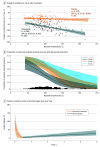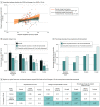Association of Amyloid Reduction After Donanemab Treatment With Tau Pathology and Clinical Outcomes: The TRAILBLAZER-ALZ Randomized Clinical Trial
- PMID: 36094645
- PMCID: PMC9468959
- DOI: 10.1001/jamaneurol.2022.2793
Association of Amyloid Reduction After Donanemab Treatment With Tau Pathology and Clinical Outcomes: The TRAILBLAZER-ALZ Randomized Clinical Trial
Abstract
Importance: β-amyloid plaques and neurofibrillary tau deposits biologically define Alzheimer disease.
Objective: To perform post hoc analyses of amyloid reduction after donanemab treatment and assess its association with tau pathology and clinical measures.
Design, setting, and participants: The Study of LY3002813 in Participants With Early Symptomatic Alzheimer's Disease (TRAILBLAZER-ALZ) was a phase 2, placebo-controlled, randomized clinical trial conducted from December 18, 2017, to December 4, 2020, with a double-blind period of up to 76 weeks and a 48-week follow-up period. The study was conducted at 56 centers in the US and Canada. Enrolled were participants from 60 to 85 years of age with gradual and progressive change in memory function for 6 months or more, early symptomatic Alzheimer disease, elevated amyloid, and intermediate tau levels.
Interventions: Donanemab (an antibody specific for the N-terminal pyroglutamate β-amyloid epitope) dosing was every 4 weeks: 700 mg for the first 3 doses, then 1400 mg for up to 72 weeks. Blinded dose-reduction evaluations occurred at 24 and 52 weeks based on amyloid clearance.
Main outcomes and measures: Change in amyloid, tau, and clinical decline after donanemab treatment.
Results: The primary study randomized 272 participants (mean [SD] age, 75.2 [5.5] years; 145 female participants [53.3%]). The trial excluded 1683 of 1955 individuals screened. The rate of donanemab-induced amyloid reduction at 24 weeks was moderately correlated with the amount of baseline amyloid (Spearman correlation coefficient r, -0.54; 95% CI, -0.66 to -0.39; P < .001). Modeling provides a hypothesis that amyloid would not reaccumulate to the 24.1-centiloid threshold for 3.9 years (95% prediction interval, 1.9-8.3 years) after discontinuing donanemab treatment. Donanemab slowed tau accumulation in a region-dependent manner as measured using neocortical and regional standardized uptake value ratios with cerebellar gray reference region. A disease-progression model found a significant association between percentage amyloid reduction and change on the integrated Alzheimer Disease Rating Scale only in apolipoprotein E (APOE) ε4 carriers (95% CI, 24%-59%; P < .001).
Conclusions and relevance: Results of post hoc analyses for donanemab-treated participants suggest that baseline amyloid levels were directly associated with the magnitude of amyloid reduction and inversely associated with the probability of achieving complete amyloid clearance. The donanemab-induced slowing of tau was more pronounced in those with complete amyloid clearance and in brain regions identified later in the pathologic sequence. Data from other trials will be important to confirm aforementioned observations, particularly treatment response by APOE ε4 status.
Trial registration: ClinicalTrials.gov Identifier: NCT03367403.
Conflict of interest statement
Figures





References
Publication types
MeSH terms
Substances
Associated data
LinkOut - more resources
Full Text Sources
Other Literature Sources
Medical
Miscellaneous

